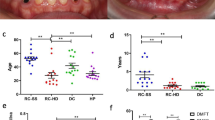Abstract
This study investigated the association between clinical and salivary or molecular parameters in Down syndrome subjects. Sixty individuals (1- to 48-year old) were clinically examined using DMFT/DMFS. Stimulated saliva was collected; salivary flow was calculated (mL/min), buffering capacity was measured using a standard pH tape. In addition, 25 μL of saliva was diluted using 10-fold-dilution method and then placed on Mitis-Salivarius-Bacitracin agar to count colony forming units (CFU/mL) of mutans streptococci. Polymerase chain reaction analysis identified species. Caries indexes were 0.65–13.5 (DMFT) and 0.65–26.0 (DMFS) according to groups. Ninety-four percent of subjects had low flow rate (0.7–1.0 mL/min) and 44% had low buffering capacity (pH < 4). Besides, 60% had more than 1 × 106 CFU/mL, 60% had S. mutans, and 41.4% had S. sobrinus. Caries indexes did not significantly correlate with flow rate, buffering capacity, CFU/mL by Pearson’s correlation (p > 0.05), and showed no significant association with prevalence of species by Chi-square (p > 0.05). There is no association between clinical picture and salivary or molecular parameters in Down syndrome subjects.
Similar content being viewed by others
References
Brown RH, Cunningham WM. Some dental manifestations of mongolism. Oral Med. 1961;14:664–6.
Creighton WE, Wells HB. Dental caries experience in Institutionalized mongoloid and nonmongoloid children in North Carolina and Oregon. J Dent Res. 1966;45:66–75.
Cohen MM, Arvystas MG, Baum BJ. Occlusal disharmonies in trissomy G (Down’s syndrome, mongolism). Am J Orthod. 1970;58:367–72.
Barnett ML, Press KP, Friedman D, Sonnenberg EM. The prevalence of periodontitis and dental caries in a Down’s syndrome population. J Periodontol. 1986;57:288–93.
Shapira J, Stabholz A. A comprehensive 30-month preventive dental health program in a pre-adolescent population with Down’s syndrome: a longitudinal study. Spec Care Dent. 1996;16:33–7.
Stabholz A, Mann J, Sela M, Schurr D, Steinberg D, Shapira J. Caries experience, periodontal treatment needs, salivary pH, and Streptococcus mutans counts in a preadolescent Down syndrome population. Spec Care Dent. 1991;11:203–8.
Morinushi T, Lopatin DE, Tanaka H. The relationship between dental caries in the primary dentition and anti S. mutans serum antibodies in children with Down’s syndrome. J Clin Pediatr Dent. 1995;19:279–84.
Cornejo LS, et al. Bucodental health condition in patients with Down syndrome of Cordoba City, Argentina. Acta Odont Latinoamer. 1996;9:65–79.
Yarat A, Akyüz S, Koç L, Erdem H, Emekli N. Salivary sialic acid, protein, salivary flow rate, pH, buffering capacity and caries índices in subjects with Down’s syndrome. J Dent. 1999;27:115–8.
Siqueira WL, Nicolau J. Stimulated whole saliva components in children with Down syndrome. Spec Care Dent. 2002;22:226–30.
Lee SR, Kwon HK, Song KB, Choi YH. Dental caries and salivary immunoglobulin A in Down syndrome children. J Paediatric Child Health. 2004;40:530–3.
Barone S, Macedo C, Marin JM. Arbitrarily primed polymerase chain reaction for fingerprinting the genotype identification of mutans streptococi in children with Down syndrome. Spec Care Dent. 2005;25:37–42.
Siqueira WL, Bermejo PR, Mustacchi Z, Nicolau J. Buffer capacity, pH and flow rate in saliva of children aged 2 to 60 months with Down syndrome. Clin Oral Invest. 2005;9:26–9.
Chaushu S, Becker A, Chaushu G, Shapira J. Stimulated parotid salivary flow rate in patients with Down syndrome. Spec Care Dent. 2002;22:41–4.
Cogulu D, Sabah E, Uzel A, Ozkina YF. Genotyping of Streptococcus mutans by using arbitrarily primed polymerase chain reaction in children with Down syndrome. Arch Oral Biol. 2006;51:177–82.
Krasse B. Biological factors as indicators of future caries. Int Dent J. 1988;38:219–25.
Napimoga MH, Kamiya RU, Rosa RT, Rosa EA, Höfling JF, Mattos-Graner RO, Gonçalves RB. Genotypic diversity and virulence traits of Streptococcus mutans in caries-free and caries-active individuals. J Med Microbiol. 2004;53:697–703.
Castilho ARF, Pardi V, Pereira CV. Caries prevalence, level of mutans streptococci, salivary flow rate, and buffering capacity in subjects with Down syndrome. Braz J Oral Sci. 2007;6:1331–6.
van Palenstein Helderman WH, Ijsseldijk M. Huis In ‘T Veld JH A selective medium for the two major subgroups of the bacterium Streptococcus mutans isolated from human dental plaque and saliva. Arch Oral Biol. 1983;28:599–603.
Davey AL, Rogers AH. Multiple types of the bacterium Streptococcus mutans in the human mouth and their intra-family transmission. Arch Oral Biol. 1984;29:453–60.
Oho T, Yamashita Y, Shimazaki Y, Kushiyama M, Koga T. Simple and rapid detection of Streptococcus mutans and Streptococcus sobrinus in human saliva by polymerase chain reaction. Oral Microbiol Immunol. 2000;15:258–62.
Bradley C, McAlister T. The oral health of children with Down syndrome in Ireland. Spec Care Dent. 2004;24:55–60.
Ulseth JO, Hestnes A, Stovner LJ, Storhaug K. Dental caries and periodontitis in persons with Down syndrome. Spec Care Dent. 1991;11:71–3.
Fejerskov O, Kidd EAM. Dental caries: the disease and its clinical management. Oxford: Blackwell; 2003.
Jordan HV, Keyes PH. “In vitro” methods for the study of plaque formation and carious lesions. Arch Oral Biol. 1966;11:793–801.
Wu H, et al. Detection of Streptococcus mutans and Streptococcus sobrinus on the permanent first molars of the Mosuo people in China. Caries Res. 2003;37:374–80.
Pereira CV, Pereira LJ, Gonçalves RB, Höfling JF. In vitro bacterial plaque suppression, recolonization by S. mutans, S. sobrinus. Braz J Microbiol. 2006;37:20–5.
Acknowledgments
The study was supported by Fundação de Amparo à Pesquisa do Estado de São Paulo (FAPESP-Grant 04/12925-0).
Author information
Authors and Affiliations
Corresponding author
Rights and permissions
About this article
Cite this article
de Castilho, A.R.F., Pardi, V. & Pereira, C.V. Dental caries experience in relation to salivary findings and molecular identification of S. mutans and S. sobrinus in subjects with Down syndrome. Odontology 99, 162–167 (2011). https://doi.org/10.1007/s10266-011-0010-9
Received:
Accepted:
Published:
Issue Date:
DOI: https://doi.org/10.1007/s10266-011-0010-9




